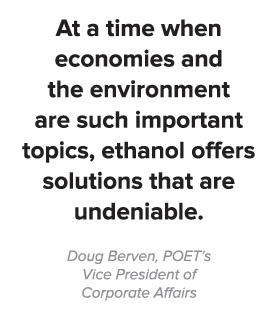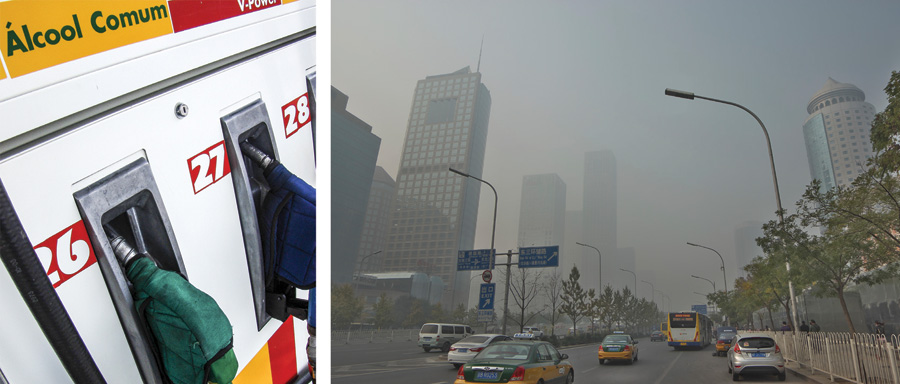Since ethanol facilities first began dotting the rural landscape of the Midwest, the story of ethanol has been a tale told close to home. Good for rural communities, good for the country’s environment, good for the consumer’s pocketbook – even good for the nation’s security.
But there’s another side to the ethanol story, one that isn’t told quite as often: the story of a growing export market for ethanol. While the continued battle over domestic renewable fuel mandates tends to grab headlines, the development of export markets – offering new revenue streams – is becoming increasingly integral to the industry’s future.
U.S. ethanol exports have grown over 40 percent since 2013 alone, with industry experts predicting about 900 million gallons going to foreign customers once the books are closed on 2015.
“The U.S. is exporting around 6 to 7 percent of its total ethanol production, generating over $2 billion in export revenues, an important economic consideration for those U.S. producers who sell into the export market as well as those who only market domestically since exports represent an outlet for surplus domestic production,” notes Jim Miller, Vice President and Chief Economist for Growth Energy.
The U.S. first began exporting more ethanol than it was importing back in 2010. Growth in Canadian and European markets, coupled with increased demand in Brazil, boosted 2011 ethanol exports to record levels of 1.2 billion gallons, due in large part to a poor sugarcane harvest which fueled Brazil’s need to import more ethanol. While 2014 shaped up to be the second largest overseas sales year with over 834 million gallons, 2015 is likely to surpass it once the final tally is done.
Growth in exports is timely, as the domestic market grapples with the fundamentals of supply and demand. “We are extremely effective at growing crops for feedstock for ethanol biorefineries and we have companies like POET that are global leaders in developing biorefining technology. We are capable of producing a significant amount of ethanol supply that exceeds the current domestic demand,” says Klay Gross, who heads up POET’s Ethanol Products commercial ethanol business.
Of course, that extra supply can be addressed by either decreasing production or increasing demand. But cutting production harms the rural economy and diminishes progress in replacing fossil fuels. To firm up demand, the industry continues to push for a domestic blend percentage higher than the current 10 percent. But growing export markets can bring an upturn in demand as well.
“First, ethanol is more cost effective than hydrocarbon fuels. Second, it’s a better quality fuel due to its higher-octane content and cleaner burning attributes,” Gross says. “Next, countries will be looking to their own natural resources and determining whether they can develop their own ethanol production. But first they have to import the ethanol to develop the fuel system.”
He believes other countries will see the progress the U.S. has made toward independence from Middle Eastern oil supplies and want to follow suit. Many of the countries interested in importing U.S. ethanol are reliant on the Mideast for transportation fuels.
“Even with crude oil falling to $40 and a very strong U.S. dollar compared to other foreign currencies, we believe the product quality, environmental benefits and renewable attributes of ethanol will prevail over the use of fossil fuels,” Gross predicts.
Miller believes environmental concerns will begin to have a greater impact on demand for ethanol as well. “U.S. ethanol provides an average 34 percent reduction in Greenhouse Gas emissions (GHGs) even when the controversial Indirect Land Use Change charges are included,” he adds. “In addition, ethanol reduces the need for other expensive, toxic, and in many cases, carcinogenic, compounds to be added to gasoline as oxygenates and octane boosters.”
While tightening supply may be the immediate objective, developing a robust, globally traded ethanol market also enhances the sustainability of ethanol as a commodity. “It becomes a tremendous opportunity for U.S. biorefineries due to the advanced technology and abundance of feedstock. It allows them to leverage their competitive advantages,” says Gross. “In the short term, it is imperative that export markets grow to increase demand to solve the oversupply situation that is developing. That’s the beauty of a good commodity – it finds solutions to correct a market and continues to grow.”
“At a time when economies and the environment are such important topics, ethanol offers solutions that are undeniable,” adds Doug Berven, POET’s Vice President of Corporate Affairs. “From a national security standpoint, most countries around the world are looking for a fuel that reduces their dependence on oil from the Middle East. Ethanol is the only product that can economically compete with gasoline.”
While the U.S. exported fuel and industrial ethanol to 114 countries in 2015, the top 12 overseas markets represented the vast majority of foreign ethanol sales – between 85 to 90 percent of total exports. Within that top 12, Canada and Brazil represent the chief destinations for U.S. ethanol, while also being the primary sources for U.S. ethanol imports. While approximately 60 countries have some renewable fuel policies in place, the policies for both these nations are well-established.
Canada, much like the U.S., has relatively flat gasoline demand. Growth is likely to remain relatively slow without an increase in the blend mandate there. Brazil, on the other hand, is a variable market. As the second largest ethanol producer and exporter with a 27.5 percent ethanol blend mandate, and sizable sugarcane-to-ethanol production, Brazil buys U.S. ethanol to meet demand that can’t be met with domestic production due to a poor growing season or infrastructure constraints.
“In addition to selling ethanol to the U.S. – primarily coastal markets – it also has export contracts with other countries such as Japan,” Miller adds. “Several other ethanol importers such as the Netherlands, United Arab Emirates and Oman are likely buying U.S. product and then reselling to third country markets as either ethanol for blending or a finished motor fuel.”
Expansion and enforceability of renewable fuel requirements overseas, along with reduction in tariff and non-tariff trade measures that limit market access to exports, are all expected to spur future export opportunities. Environmental, health and climate change concerns that continue to unfold across the globe will also come into play, as will development and expansion of infrastructure to import, transport and blend ethanol into foreign fuel supplies.
“We have a product that is cheaper, cleaner and just plain better than its competition,” says Berven. “Countries like China and India that have significant pollution problems are great prospects for export, and allies like Israel, Canada and Europe should be very interested in American ethanol versus oil out of the Middle East.”
left: Ethanol pump in Brazil; right: Smog in Beijing, China
Beyond Canada and Brazil, Gross sees the greatest potential for growing exports in countries looking to integrate ethanol into their fuel systems and to develop production facilities of their own, which in turn creates a global trading system. “Those countries today are India, China and Mexico. The driving factors are all the same: economics, air quality and energy independence,” Gross says. “But I still believe the country that holds the greatest opportunity for growth is our own. It is unfortunate that other countries see the benefits of blending past 10 percent, but we have antiquated regulations in place that restrict it from easily happening.”
Berven says the U.S. has another export customer that speaks volumes about ethanol’s attributes. “The high octane, low cost of ethanol is attractive enough that we are actually exporting ethanol to the Middle East today. That should be a good indicator of the potential of ethanol,” he says.









